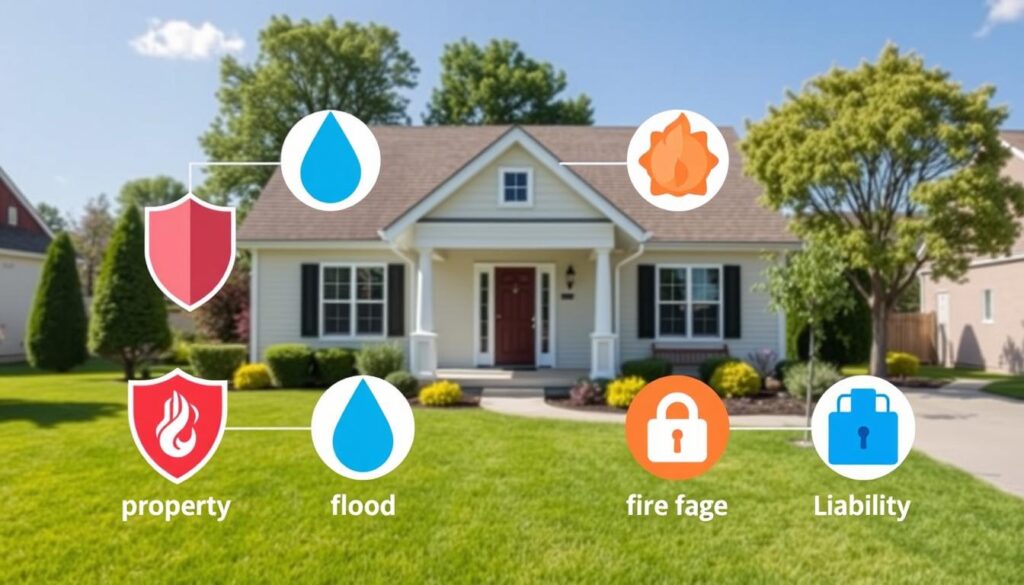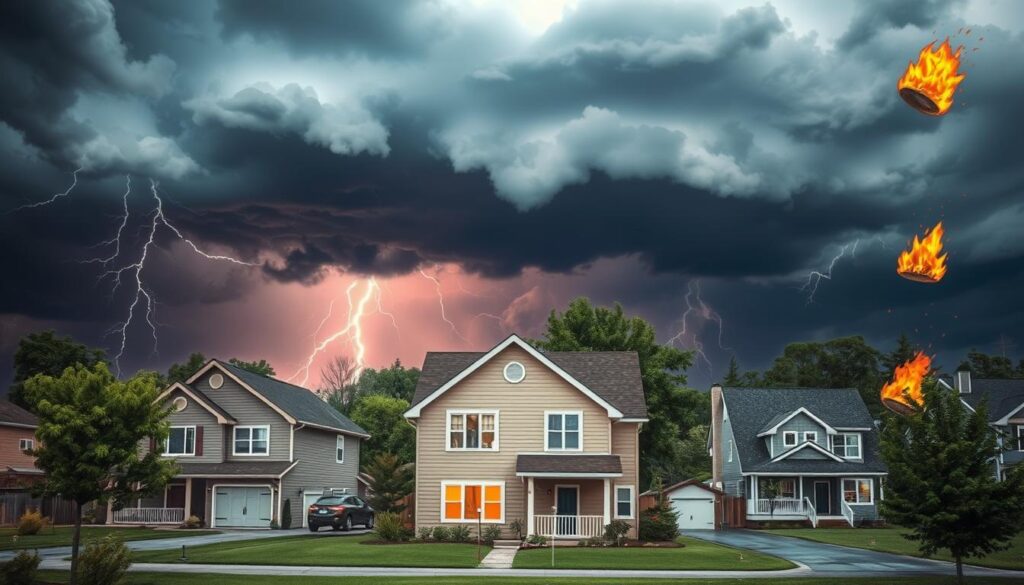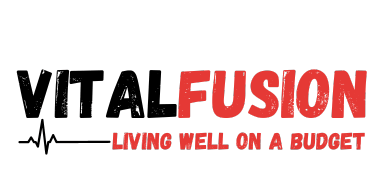As a homeowner, protecting your most significant investment is crucial. Home insurance provides the coverage you need to safeguard your property and belongings, giving you peace of mind in the face of unexpected events. In this article, we’ll explore the essential components of home insurance, helping you understand the different coverage types and how they can benefit you.

Key Takeaways
- Home insurance provides essential coverage for your property and belongings.
- Understanding the different coverage types can help you select the right policy for your needs.
- Dwelling coverage protects the structure of your home, while personal property coverage safeguards your possessions.
- Liability coverage offers legal and medical protection in the event of an accident on your property.
- Familiarizing yourself with common policy exclusions and insurance terms can help you make informed decisions.
Understanding Basic Home Insurance Coverage Types
Home insurance is a crucial financial safeguard, providing coverage for your dwelling, personal property, and liability protection. To fully understand your policy, let’s dive into the key components of standard home insurance coverage.
Key Components of Standard Coverage
A standard home insurance policy typically includes the following core elements:
- Dwelling coverage: This covers the structure of your home, including the roof, walls, and foundation, in the event of damage or destruction.
- Personal property coverage: This protects your belongings, such as furniture, electronics, and clothing, if they are stolen or damaged.
- Liability protection: This coverage helps protect you financially if someone is injured on your property or you are found legally liable for damages.
Common Policy Exclusions
It’s important to be aware of the common exclusions in home insurance policies, which may include:
- Damage caused by floods, earthquakes, or other natural disasters (these may require separate policies).
- Wear and tear or lack of maintenance on your home.
- Damage caused by pests or infestations.
- Intentional or criminal acts committed by the policyholder.
Insurance Terms You Should Know
Understanding the following insurance terminology can help you navigate your policy and make informed decisions:
| Term | Definition |
|---|---|
| Deductible | The amount you pay out of pocket before your insurance coverage kicks in. |
| Premium | The monthly or annual cost of your insurance policy. |
| Actual Cash Value (ACV) | The depreciated value of your personal property, which is what your insurer will pay out. |
| Replacement Cost | The amount needed to replace your personal property with new, similar items. |
By understanding the key components of standard home insurance coverage, common exclusions, and essential insurance terms, you can make informed decisions about protecting your dwelling, personal property, and liability.
Dwelling Coverage: Protecting Your Home’s Structure
When it comes to homeowners insurance, one of the most crucial components is dwelling coverage. This coverage protects the physical structure of your home, including the walls, roof, and foundation. It’s designed to cover the cost of repairing or rebuilding your home in the event of a covered loss, such as a fire, storm, or other natural disaster.
The amount of dwelling coverage you need is typically based on the estimated replacement cost of your home. This takes into account factors like the size, age, and construction materials of your property. It’s essential to ensure your dwelling coverage limit is high enough to fully rebuild your home in the event of a total loss.
Factors that can influence your dwelling coverage limit include the local construction costs in your area, the square footage of your home, and any unique architectural features or upgrades. Regularly reviewing your coverage with your insurance provider can help you maintain adequate protection for your most valuable asset – your home.
| Dwelling Coverage Considerations | Explanation |
|---|---|
| Replacement Cost | The estimated cost to rebuild your home from the ground up, including materials and labor. |
| Home Size | The square footage of your home, which affects the overall rebuild cost. |
| Construction Materials | The type of materials used in your home’s construction, such as wood, brick, or concrete. |
| Home Upgrades | Any custom features or renovations that increase the value of your home. |
By understanding the importance of dwelling coverage and ensuring your limits are adequate, you can have peace of mind knowing that your home’s structure is well-protected under your homeowners insurance policy.
Personal Property Protection: Safeguarding Your Belongings
Your home insurance policy not only protects the structure of your house, but it also safeguards your personal property – the belongings inside your home. This coverage, known as personal property coverage, is crucial in ensuring your valuable items are protected in case of unexpected events, such as theft, fire, or natural disasters.
Special Limits on Valuable Items
While your standard home insurance policy provides coverage for your personal property, there are often special limits on high-value items, such as jewelry, fine art, or collectibles. These items may require additional coverage or riders to ensure they are fully protected. It’s important to review your policy and understand these limits to ensure your most valuable possessions are adequately covered.
Actual Cash Value vs. Replacement Cost
When it comes to personal property coverage, you’ll typically have the choice between actual cash value (ACV) or replacement cost coverage. ACV takes into account the depreciated value of your items, while replacement cost coverage will pay to replace your belongings with new, similar items. Understanding the difference between these two options can help you make an informed decision about the level of coverage that best fits your needs and budget.
Creating a Home Inventory
- One of the most important steps in ensuring your personal property is properly covered is creating a home inventory. This comprehensive list of your belongings, along with their approximate values, can be invaluable in the event of a claim.
- A home inventory can help you accurately document your possessions, making the claims process much smoother and ensuring you receive the full value of your coverage.
- Consider taking photos or videos of your belongings, and store the inventory in a secure location, such as a safe deposit box or a cloud-based storage service.
By understanding the nuances of personal property coverage, you can tailor your home insurance policy to best protect the things that matter most to you and your family.
Liability Coverage: Legal and Medical Protection
As a homeowner, liability protection is a crucial component of your homeowners insurance policy. This coverage safeguards you from the financial burden of legal and medical expenses if someone is injured on your property. Whether it’s a guest who slips and falls or a delivery person who sustains an injury, liability coverage has got you covered.
Typical liability coverage limits range from $100,000 to $500,000, with the option to increase this amount for additional liability protection. This coverage kicks in to pay for the injured party’s medical bills, lost wages, and even legal fees if a lawsuit arises. It’s important to review your policy and ensure you have adequate limits to protect your assets in the event of a claim.
Imagine a scenario where a neighbor’s child is playing in your yard and breaks their arm after falling off your swing set. Without liability coverage, you could be responsible for the child’s medical expenses and any legal fees associated with the incident. However, with the right homeowners insurance policy in place, your liability coverage would step in to handle these costs, shielding you from financial hardship.
Liability protection is a small investment that can provide substantial peace of mind and safeguard your financial well-being. By understanding the importance of this coverage, you can ensure that you and your family are protected in the event of an unexpected accident or injury on your property.

“Liability coverage is the backbone of a comprehensive homeowners insurance policy, protecting you and your assets from unexpected legal and medical costs.”
Additional Living Expenses Coverage: When Disaster Strikes
Imagine a scenario where a natural disaster or other covered event renders your home uninhabitable. In such trying times, you might need to find temporary housing and cover additional living expenses. This is where your home insurance’s additional living expenses (ALE) coverage steps in to provide crucial financial support.
Temporary Housing Costs
ALE coverage typically helps with the costs of a hotel, motel, or short-term rental while your home is being repaired or rebuilt. This can include expenses like:
- Temporary rent or hotel bills
- Restaurant meals and takeout
- Laundry services
- Storage for your personal belongings
Qualifying Events
ALE coverage kicks in when your home becomes uninhabitable due to a covered event, such as a fire, storm, or other natural disaster. It’s important to review your policy carefully to understand the specific qualifying events that would trigger this coverage.
While the exact limits and details may vary, ALE coverage can provide valuable financial assistance during a difficult time, helping you maintain your standard of living while your home is being repaired or rebuilt.
| Covered Event | Temporary Housing Covered | Typical Coverage Limit |
|---|---|---|
| Fire | Yes | 20% of dwelling coverage |
| Hurricane | Yes | 30% of dwelling coverage |
| Tornado | Yes | 25% of dwelling coverage |
| Earthquake | No, unless purchased as a separate policy | N/A |
Remember, the specific details and coverage limits of your additional living expenses (ALE) protection may vary based on your insurance policy. It’s always a good idea to review your coverage and talk to your insurance provider to ensure you have the right level of protection in case a disaster strikes.
Natural Disaster Coverage and Special Considerations
When it comes to homeowners insurance, understanding natural disaster coverage is crucial. Standard home insurance policies often have exclusions for certain types of natural disasters, such as floods and earthquakes. This means that if your home is damaged by one of these excluded events, your regular home insurance may not provide the necessary coverage.
To ensure comprehensive protection against natural disasters, it’s essential to review your policy and consider the need for additional coverage. Some key points to consider:
- Flood insurance is typically a separate policy that must be purchased, as it is often excluded from standard homeowners insurance.
- Earthquake insurance may also be a separate policy or a rider added to your existing homeowners coverage.
- Other natural disasters, like tornados, hurricanes, and wildfires, may be covered by your standard homeowners policy, but it’s important to check the details and limits of your specific plan.
Understanding the natural disaster coverage in your homeowners insurance policy is the first step in protecting your home and your family. Be sure to review your policy, discuss your needs with your insurance provider, and consider additional coverage if necessary to ensure you are fully prepared for the unexpected.

“Protecting your home against natural disasters is essential, but it requires careful consideration of your insurance coverage. Don’t wait until it’s too late – review your policy today.”
High-Value Item Riders and Policy Add-ons
Homeowners insurance may not always cover the full value of your most prized possessions, such as jewelry, art, electronics, and specialty equipment. That’s where high-value item riders and policy add-ons come into play. These specialized coverage options can protect your investments and give you peace of mind.
Jewelry and Art Coverage
Standard home insurance policies typically have limited coverage for valuable items like jewelry and art. If you own expensive pieces, you may need to purchase a rider to ensure they are properly protected. These riders can cover the full replacement cost of your jewelry or artwork, protecting you from financial loss in the event of theft, damage, or other covered perils.
Electronics and Specialty Equipment
In today’s tech-driven world, your home may be filled with high-value electronic devices and specialized equipment. From sophisticated camera gear to professional-grade power tools, these items may require additional coverage beyond your standard personal property coverage. By adding a rider, you can safeguard these high-value item riders and ensure they are replaced or repaired if something unexpected happens.
| Item | Typical Coverage Limit | Rider Coverage |
|---|---|---|
| Jewelry | $1,500 – $2,500 | Full replacement cost |
| Fine Art | $2,500 – $5,000 | Agreed value or full replacement cost |
| Cameras and Photography Equipment | $1,000 – $2,000 | Agreed value or full replacement cost |
| Musical Instruments | $1,000 – $2,500 | Agreed value or full replacement cost |
By understanding the limitations of your standard homeowners policy and exploring the availability of high-value item riders and policy add-ons, you can ensure your most prized possessions are properly protected. Take the time to review your coverage and determine if additional protection is necessary to safeguard your valuable items.
Understanding Deductibles and Premium Costs
When it comes to homeowners insurance, two crucial factors to consider are deductibles and premium costs. Understanding how these elements work can help you strike the right balance between coverage and affordability.
Your deductible is the amount you agree to pay out-of-pocket before your insurance coverage kicks in. Deductibles can range from $500 to $2,500 or more, and choosing a higher deductible can lower your premium costs. However, it’s essential to ensure your deductible is manageable in the event of a claim.
The premium, on the other hand, is the recurring payment you make to maintain your homeowners insurance policy. Premiums are influenced by various factors, including the size and age of your home, your location, the coverage limits you select, and your claims history.
To find the right balance, consider your financial situation and the level of risk you’re comfortable with. A higher deductible can mean lower monthly or annual premiums, but it also means you’ll need to be prepared to cover a more significant out-of-pocket expense if you file a claim. Conversely, a lower deductible may provide more peace of mind, but it will likely result in higher premium costs.
By understanding the relationship between deductibles and premium costs, you can make an informed decision about the homeowners insurance coverage that best suits your needs and budget.
How to Choose the Right Coverage Levels
When it comes to homeowners insurance, selecting the right coverage levels is crucial to ensure you’re adequately protected. Start by carefully reviewing your home’s value, the value of your personal belongings, and your liability risks. This will help you determine the appropriate limits for your dwelling coverage, personal property protection, and liability coverage.
Remember, as your life circumstances change, such as major home renovations, purchasing valuable items, or welcoming a new family member, your insurance needs may also evolve. Regularly review your policy and adjust your coverage levels accordingly. This proactive approach will give you the peace of mind of knowing your home and assets are properly insured, no matter what life throws your way.
By understanding the various coverage types and selecting the right limits, you can tailor your homeowners insurance to fit your unique needs. With the right protection in place, you can focus on enjoying your home and creating lasting memories, confident that you’re covered in the event of the unexpected.
FAQ
What are the key components of standard home insurance coverage?
The key components of standard home insurance coverage include dwelling coverage, personal property protection, and liability protection. Dwelling coverage protects the structure of your home, personal property coverage safeguards your belongings, and liability coverage provides legal and medical protection if someone is injured on your property.
What are some common exclusions in home insurance policies?
Common exclusions in home insurance policies include damage caused by floods, earthquakes, nuclear events, and intentional acts. It’s important to understand what your policy does and does not cover to ensure you have the right level of protection.
What is the difference between actual cash value and replacement cost coverage?
Actual cash value coverage pays you the depreciated value of your damaged or stolen items, while replacement cost coverage pays the full cost to repair or replace them. Replacement cost coverage is generally more comprehensive, but it also typically comes with a higher premium.
How can I ensure my high-value items are properly covered?
To ensure your high-value items like jewelry, art, or electronics are properly covered, you may need to purchase additional riders or endorsements to your home insurance policy. These add-ons provide coverage beyond the standard personal property limits.
What is additional living expenses coverage, and when does it apply?
Additional living expenses coverage helps pay for temporary housing, food, and other living costs if your home becomes uninhabitable due to a covered event, such as a fire or natural disaster. This coverage kicks in when your home is undergoing repairs or is deemed unlivable.
How do deductibles and premiums work in home insurance?
Your deductible is the amount you pay out-of-pocket before your insurance coverage kicks in. Choosing a higher deductible can lower your monthly premium, but it also means you’ll have to pay more if you need to file a claim. Your premium is the cost of your home insurance policy, which can be influenced by factors like your location, the age of your home, and your coverage levels.
What should I consider when choosing the right home insurance coverage?
When choosing home insurance coverage, consider factors like the value of your home and belongings, your liability risks, and your financial situation. It’s important to balance your coverage needs with your budget to ensure you have the right protection without overpaying. Regularly reviewing and updating your policy as your circumstances change is also recommended.
Related topics:
10 Proven Tips to Save Money on Your Auto Insurance Premiums
Finding Affordable Health Insurance Options for Freelancers in 2024






